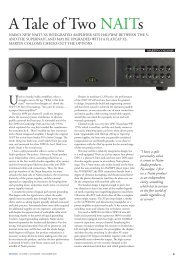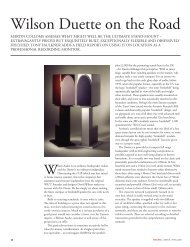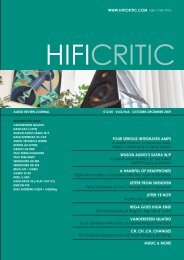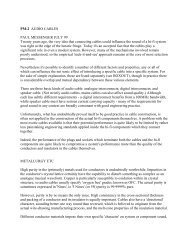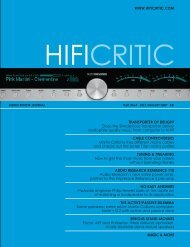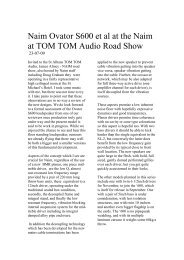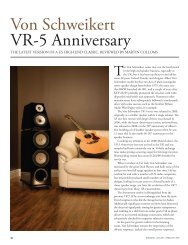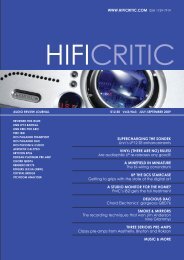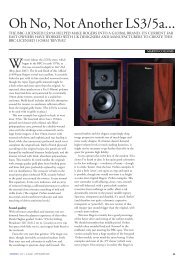The Unseen Variable - Hificritic.com
The Unseen Variable - Hificritic.com
The Unseen Variable - Hificritic.com
Create successful ePaper yourself
Turn your PDF publications into a flip-book with our unique Google optimized e-Paper software.
I've used the Wilson X-1 as an example, because<br />
its performance is audibly limited by even the<br />
finest SE tubed amplifiers-despite its nominally<br />
<strong>com</strong>patible load factor. In my own work (I don't<br />
own a pair of X-1s), I continue to find<br />
correlations to my X-1 experience. My Quad<br />
ESL-63s are sufficiently low in distortion to<br />
expose SE amplifiers once the output level rises<br />
above a few watts. <strong>The</strong>y also need at least 50W<br />
to get acceptably loud. My WATT Vs do play<br />
louder than the Quads, but they're also lowdistortion<br />
designs: single-ended amplifiers<br />
played reasonably loud sound increasingly<br />
thinner and harder tonally, and the second- and<br />
third-harmonic products be<strong>com</strong>e increasingly<br />
audible.<br />
I have had more success with higher-distortion<br />
loudspeakers averaging, say, 0.3-0.5% THD in<br />
the midband-particularly if they have smooth<br />
impedance characteristics and fairly limited bass<br />
extension. With such speakers, the sonic virtues<br />
of SE tube amplifiers stand out more clearly,<br />
confirming my view of their niche-market<br />
application.<br />
<strong>The</strong> 3.3 ohm amplifier output resistance test<br />
One of the problems for someone auditioning a<br />
good SE amplifier for the first time is that all<br />
audiophiles have a psychological need to hear a<br />
difference. Some audio differences, while<br />
important, are quite subtle. <strong>The</strong>ir analysis<br />
requires fine equipment, good circumstances,<br />
and, in some cases, extended listening.<br />
However, when <strong>com</strong>pared with a conventional,<br />
solid-state, or push-pull low-impedance tube<br />
amplifier, a single-ended tube amplifier will<br />
always sound substantially different. This is due<br />
to the <strong>com</strong>plex interaction of an SE design with<br />
typical loudspeaker loads-as well as their<br />
nonlinear behavior at high listening levels.<br />
Unfortunately, this provides immediate<br />
vindication for the listeners, reassuring them that<br />
they are skillful, sensitive, and capable.<br />
<strong>The</strong>re is therefore the attendant danger in such<br />
<strong>com</strong>parisons of confusing the acknowledged<br />
positive aspects of SE tube amplifiers with other<br />
changes. In fact, there is a distinct danger of<br />
making a virtue out of the entire sonic package.<br />
Accordingly, I designed a very simple test to see<br />
whether just one of the variables in this<br />
subjective problem can be evaluated in isolation.<br />
That variable is source impedance.<br />
In the days when "specmanship" was the name<br />
of the game, amplifier manufacturers boasted of<br />
very high damping factors-even claiming figures<br />
of several thousand in some cases. Damping<br />
factor is the ratio between the speaker load<br />
impedance-typically 8 ohms-and the output<br />
impedance of the driving amplifier.<br />
It's a trivial matter for amplifier designers to<br />
include a small fraction of the output current in<br />
the feedback loop: they can set the theoretical<br />
damping factor to infinity, or even make it<br />
negative. Even with a zero output impedance,<br />
practical damping factors are typically no better<br />
than 50 for an 8 ohm speaker (25 for a 4 ohm<br />
model), due to speaker-cable and contact<br />
resistances. (<strong>The</strong> load impedance in this<br />
discussion is defined as that existing at the<br />
loudspeaker terminals. I am treating the<br />
loudspeaker as an electro-acoustic "black box"<br />
here, not delving into its inner structure, which<br />
includes several finite resistances.)<br />
As single-ended tube amplifiers have output<br />
resistances in the 2-5 ohm range, I settled on a<br />
median value of 3.3 ohms for this investigation.<br />
This results in a damping factor (8 ohms) of just<br />
2.4.<br />
One detail required resolution: Should the<br />
listening test be conducted with the volume<br />
setting unchanged, or should the average<br />
midrange loudness be adjusted to take into<br />
account the attenuation introduced by the<br />
resistor? If the speaker system used could be<br />
considered as an 8 ohm design in the region<br />
responsible for perceived loudness, then the drop<br />
in level would be exactly 3dB.<br />
Clearly the power level should be raised to take<br />
into account this loss. But by how much? A<br />
simple rise in level is hard to judge, since the<br />
loudness gain will be uneven over the frequency<br />
range. In practice, as with loudspeaker listening<br />
tests, all the assessors can do is to judge<br />
loudness by ear (footnote 1).<br />
Two loudspeakers were auditioned for the<br />
listening tests: the Wilson WATT V and the<br />
Audio Physic Tempo. <strong>The</strong> former is a nearfield<br />
monitor, consequently showing a forward mid-




